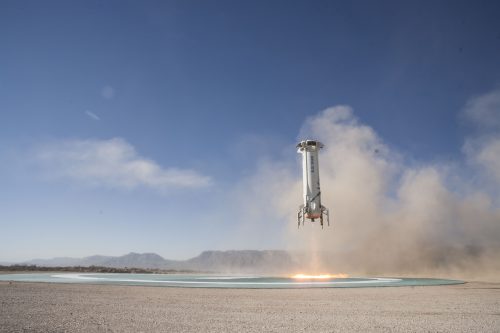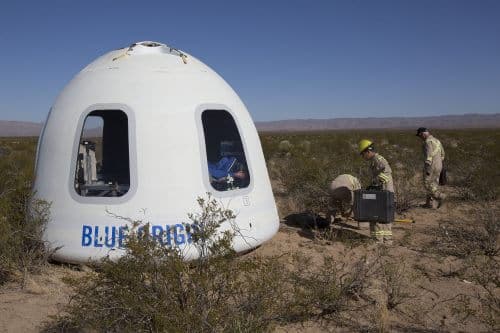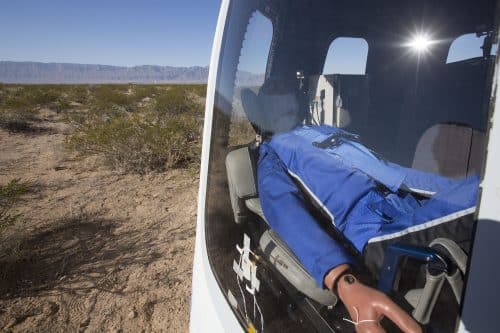Blue Origin, the private space company founded by the owner of Amazon and the richest man in the world, Jeff Bezos, on Tuesday launched a new model of its sub-orbital and multi-purpose launch vehicle, "New Shepard", in another step towards carrying out manned tourist flights space. In the new model, huge windows were installed for the first time that will provide an impressive viewing experience for future space tourists.

On Tuesday (Tuesday), Blue Origin performed a successful unmanned test of the multipurpose launch vehicle "New Shepard", a nickname that refers to both the rocket launcher and the space capsule placed on top of it. The capsule is designed to hold up to six space tourists, or scientific experiments, to be launched tosuborbital flight - that is, one that only reaches the recognized official border of space at an altitude of 100 km (Kerman line), without entering orbit around the Earth.
The New Shepard is named after the first American astronaut, Alan Shepherd, because his flight, aboard the Mercury spacecraft in 1961, was also suborbital.
The suborbital launcher is completely multi-purpose, with its launcher making a vertical motorized landing after launch, while the capsule detaches from it and lands using parachutes. The New Shepard opposite The first vehicle in history to successfully land after a suborbital launch, on its second test flight on November 23, 2015.
Watch an edited video of the successful launch and landing:
Yesterday's test flight marks the return to activity of the experimental program in New Shepard, designed to train it for manned flights, after a break of more than a year. The last test flight of its previous model was in October 2016, and the company retired it after five successful flights and landings.
The current test flight is the seventh of the New Shepard, and the first of its improved model. The innovation is a new version of the vehicle's capsule, which the company calls "Crew Capsule 2.0", which was equipped for the first time with an array of large windows (the previous model only had Window painting on the body of the spacecraft). The windows will improve the flight experience of future space tourists, and will provide them with a panoramic view of the landscape seen from a height of 100 km. According to Blue Origin, these are the largest windows designed for any spacecraft - they are 73 centimeters wide and 109 centimeters high.
"New Shepard's flight today was a great success", said CEO of Blue Origin Bob Smith, in the company's announcement. "It marks the maiden flight of the next generation of our crew capsule, as we move forward step by step in our test flight program."

Yesterday's test was carried out from a Blue Origin launch site in West Texas, at 10:59 am (local time). The company carried out the experiment in secrecy, and announced it only late that day.
During the flight, the New Shepard reached an altitude of 99 km, a single kilometer from the official limit of space, and a maximum speed of Mach 2.94 at takeoff. After detaching from the capsule, the launcher made a successful and precise vertical landing on the landing pad, and the capsule deployed its parachutes for a successful landing as well. The total duration of the flight, until the landing of the capsule, took 10 minutes and 6 seconds.
The capsule contained 12 "various scientific, commercial and educational experiments", according to Blue Origin's statement. In addition, a test dummy was placed in the capsule, her neighborhood "Skywalker", in which various devices and sensors were installed to test how the flight would affect humans. "She had a great flight," Tweet on Twitter Blue Origin founder Jeff Bezos.

In addition to the "New Shepard" vehicle for suborbital space tourism flights, Blue Origin Apple iPhone Also an orbital and multipurpose launch vehicle, theNew Glen” (named after the first American astronaut to orbit the Earth, John Glenn). The planned launcher will be quite powerful, and will be able to carry 45 tons to low-earth orbit. Like SpaceX's Falcon 9, only its first stage will be able to perform a vertical landing after launch, so it's more accurate to call it "partially multi-purpose," since the second rocket stage (and in New Glenn's case, an optional third rocket stage as well) will not be multi-purpose. useful. The company intends to make a first flight on the New Glen launcher in 2020. The company is working on other projects, including a proposal it recently presented to NASA, develop a lunar lander for it that you can place 4.5 tons on the lunar surface, to help establish a manned base on it.
See more on the subject on the science website:
- Blue Origin reveals a huge launcher that will compete with SpaceX's Falcon 9
- Blue Origin succeeded for the first time in the history of the space program in safely landing a reusable space launcher
- Delivery service to the moon: Blue Origin offers to build a lander to deliver supplies to a manned base on the moon

2 תגובות
These are still playing "I think" - and Space X launched another Dragon capsule (second-hand) to the space station with a Falcon 9 launcher (second-hand), landed it properly and everything else also worked and ticked like clockwork.